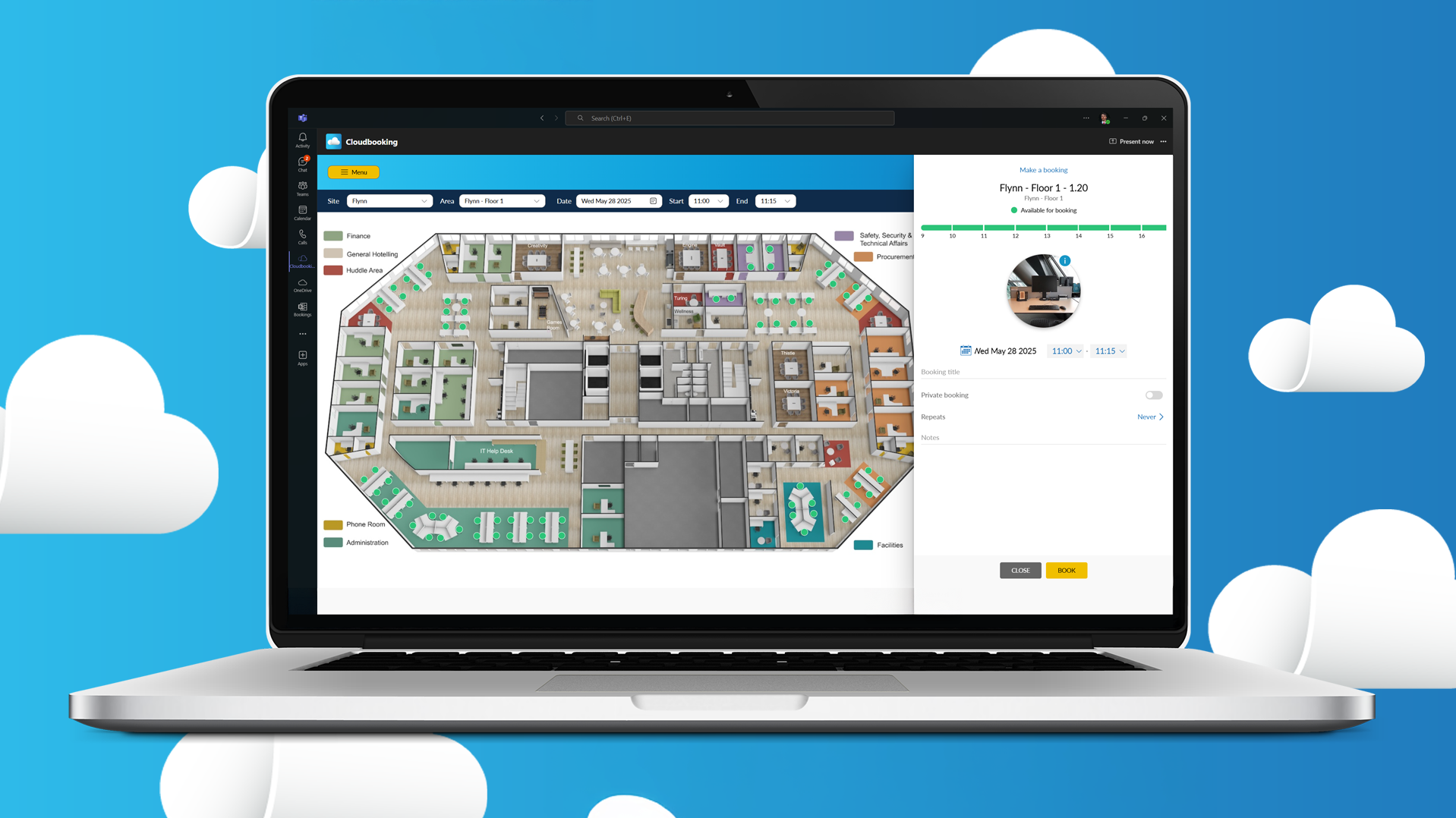
The future of work collaboration is a hot topic at the moment. Businesses across the globe are striving to become more creative and collaborative in a changing environment. At the heart of this is the development of new tools and technologies which facilitate greater collaboration than ever before. At the same time, workers embrace greater flexibility via remote working practices that were unimaginable just a few decades ago. This post will explore what collaboration in the workplace means and consider how to get workplaces collaboration ready.
Get a free demo
Enquire about a no-obligation demo today and get an exclusive hybrid working research paper — for free. Created in partnership with YouGov, this invaluable guide provides essential insights into developing your own effective hybrid strategy. Click below.
What is collaboration in the workplace?
Collaboration is the interaction of two or more people working together cooperatively to achieve an objective. It can be seen as the opposite of competition and has been proven to improve workers, teams, and organizations. When businesses are collaborative, they encourage employees from different departments and diverse backgrounds to work together seamlessly towards shared goals.
In its simplest form, it is essentially a synonym for teamwork. However, the term collaboration has come to mean something more significant than teamwork in the modern era. Intrinsic to collaboration in contemporary workplaces is technology.
The future of work looks very different from the way it was in the past. Traditionally, workers were required to occupy the same physical space for collaboration and teamwork to happen. Advancements in technology are mainly behind the disruption to this trend.
Armed with the right tools and technologies, workers are now able to collaborate effectively from virtually any location. Physical distance is no longer a barrier.
How technology facilitates remote collaboration
More people than before are either electing to work remotely or are required to do so by their employers. This trend has proved popular amongst both businesses and their workforces.
For businesses, remote working brings substantial cost savings. It significantly reduces the need for physical space and the operational costs that come with this. For workers, it brings greater autonomy, improved wellbeing, and a better work-life balance. It’s a win-win.
However, remote collaboration would not be possible without the advanced tools of modern technology – many of which are designed specifically for this purpose.
For example, many remote teams use collaborative platforms to share content and information. This enables them to work together with a high level of efficiency that would have been inconceivable just a few decades ago. Cloud-based systems provide accessibility for all team members from virtually any location. Specially designed platforms facilitate project working and allow multiple people to access, edit and share documents.
Managed cloud services eliminate the need for workers or businesses to bear the burden of maintenance and storage. They also provide expert service and assistance at a fraction of the cost of traditional systems and processes.
Physical devices are another aspect of technology that facilitates workplace collaboration like never before. Portable devices are fully equipped to support smart office systems and tools for collaboration. Whether workers are at home, the office, on the go, or anywhere else, they can access the people, information, and technologies they need to collaborate effectively.
What does the future of work collaboration look like?
The future of work collaboration is a collaborative workplace where everyone has access to the people, information, and technologies they need to collaborate effectively. This might mean that your company may have physical devices like laptops or tablets for workers who are on the go, so they can also access the resources that they’d usually only be able to find at the office.
Due to the global pandemic, the marketplace for collaboration technology has evolved more rapidly than anyone could have anticipated. This is fuelled by the needs and demands of businesses and workers as they adapt to new ways of operating.
As a result, we have become more adaptable and experimental in our working practices than ever before. Workers and businesses have had to use and learn multiple new technologies in a matter of weeks. This has created an awareness of what is possible and a widespread willingness to embrace change.
This is a significant culture shift for many and a trend that looks set to continue. There is now an abundance of tools at the disposal of businesses. As we move forward, the key to greater success will lie in how these tools and systems are integrated for maximum efficacy.
How can businesses get ready for the future of workplace collaboration?
What should businesses do to get ready for the changes ahead and anticipate their needs in a digital workplace environment?
In one sense, the future is already here, so preparation is somewhat retrospective. Organizations that have adapted well to remote working during the pandemic can view this period as experimentation. It has been trial and error to see what works and what is needed to facilitate greater collaboration amongst workers.
Experimentation is critical in the early stages of new technology and culture adoption. Companies should not be afraid of trying things to discover what works and uncover gaps in their processes. Once they know what works best for their business and workforce, this can be enhanced and improved over time.
Businesses should focus on ease of use and enhanced connectivity between individuals and teams when selecting tools and technologies. Communication is central to effective collaboration. This should, therefore, be amongst the first considerations for businesses when preparing for the future of work.
Video conferencing tools are a must. Most businesses have likely already utilized these extensively over the past year or so. If the current tools are working, there may not be a need to change these at this time. It’s essential to bear in mind that any changes will require coaching and training for workers to learn how to use them and get the most from them.
While most businesses have adapted to new technologies and practices over the past year, some are a little behind the times still. For these companies, switching to cloud-based systems should be a priority. Even where remote working is not yet widely adopted, this is likely to change across many sectors. Preparation for facilitating remote working now will streamline the process as it occurs.
For businesses to ensure success in the new environment, they must be willing to invest in tools and technologies that facilitate collaboration. As a result of the switch to remote working, many businesses find that they can reduce expenditure by consolidating real estate and saving on the operational costs associated with having a whole workforce on site. These savings would be wisely invested in preparing for and facilitating remote working and collaboration.
Businesses that have not yet considered how the future of work can help them reduce operational costs should bring this to the forefront of their agenda. Most companies could – and should – take advantage of this to remain competitive in this changing space.
Workplaces should view these times as a real opportunity to create and embed the culture they want within their business. This is an opportunity for teams and their leaders to connect in a completely new and perhaps even more meaningful way if the right approach is taken. This is not to be ignored as it can potentially be transformational, bringing positive change and greater productivity to businesses.
It would be wise for companies to involve their workforce in the preparation and decision-making processes. Do not assume you know what your workforce wants or needs concerning collaboration and remote working if you are a leader. Consult them. Take their views on board and use the information to inform your new business culture and the tools and technologies you adopt. Remember, these are the people that will be using these tools, and they know best what works within their teams or what they feel is needed to improve collaboration.
Integration of tools and technologies for collaboration should be front and center during the planning and preparation stages. Integrated systems are the latest in cloud technology, and they are transforming how businesses operate. Integrated systems are capable of streamlining workflow like nothing else.
By adopting integrated systems, companies can further reduce costs while significantly enhancing efficiency. These systems promote productivity because they make it so much easier for workers to complete work and connect with the people they need to. With everything integrated into one platform, training for different systems is virtually, if not entirely, eliminated. This is an intelligent way of working that is user-friendly and intuitive.
Conclusion
The future of work collaboration is driven by technology. We are witnessing a cultural shift in the workplace on a scale never seen before. The trend looks set to continue, alongside ever-greater advances in technology. As such, businesses should seek to prepare for this by investing in the right remote work collaboration tools for success.
Transform your business with Cloudbooking’s integrated tools and technologies for collaboration. Contact us now for a no-obligation product demo.


